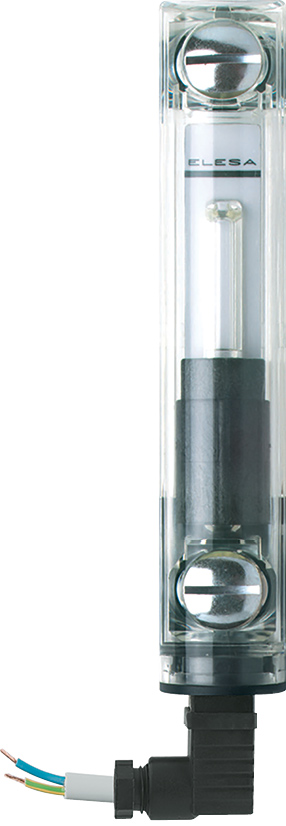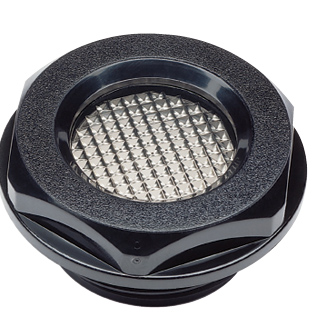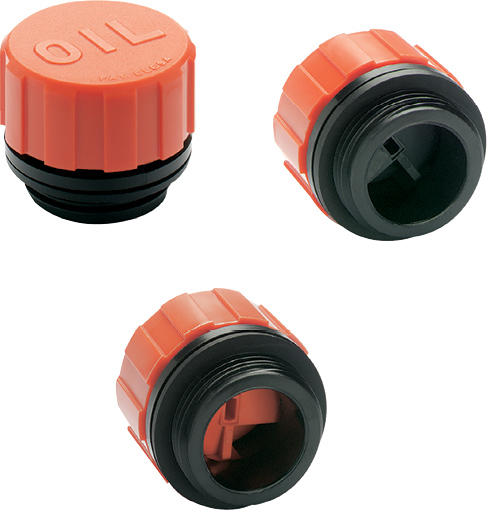
Located at each reservoir filler location, column indicators are visual controls that accurately display the level of fluid running through a system. Photos courtesy of Essentra Components
Improper fluid levels in a hydraulic system can cause a number of difficult and sometimes even catastrophic failures. For example, having too much hydraulic fluid in the reservoir can cause the reservoir to overflow when a differential cylinder retracts.
On the other hand, having too little fluid in the reservoir can introduce air into the system, causing cavitation and erratic motion. If left unchecked, air in a system can lead to foaming, which can result in unpredictable performance or even catastrophic machine failure. Without built-in safety precautions, this could leave machines to unexpectedly drop loads. Low oil levels can also reduce cooling and cause overheating, which reduces oil lubricity, reduces seal life and causes the system to run inefficiently. Noise is another byproduct of low oil, associated with pump cavitation and air in the lines.
Installing some simple devices can prevent these types of problems and warn operators that a fluid level is too low or too high for the machine. Breather caps, column level indicators, fluid level indicators and viewports can be installed on tanks and throughout the system to maintain fluid and air ratios, while also giving operators a visual indication of how much fluid is in a system.
As the first line of defense in a reservoir, breather caps help to equalize pressure in the reservoir by allowing free movement of air in and out of the reservoir as oil level rises and falls. They also feature a mesh filter to prevent contaminants from entering a system and protect the filling point. This is particularly useful for cylinder functions, as hydraulic fluid volume fluctuates throughout the reservoir as cylinders extend and retract. This venting of airflow is one way to help prevent aeration and cavitation in the system.

Fluid level indicator caps, also called oil sight glass monitors or viewports,
are small windows mounted to the outside of a reservoir marked to show upper and lower limits of fluid levels.
Because breather caps are critical in contamination prevention, they may need to be changed several times a year. High-end breather assemblies have some type of indicator to show that the filter element within them is clogged. To maintain their efficiency, it is imperative you don’t damage them, for example, by poking holes in the screens to speed up reservoir filling. Breather cap filters should have a minimum rating of at least 10 µm.
Column and fluid level indicators and viewports are best viewed when a system is not running, as that will give you a true indication of how much fluid is in a system. This is because hot oil tends to expand.
Column indicators are visual controls that accurately display the level of fluid running through a system. They should be located at each filler location and, like a temperature thermometer, show the oil level clearly on a gauge. They should be of a durable design that is resistant to shocks, vibration, solvents and oils with additives to ensure they are compatible with your application. Electronic indicators are also available, and can be equipped with analog electronic outputs to signal controllers or PLCs when oil level drops below a critical level.

Reservoir breather caps are the first line of defense in equalizing pressure and keeping contaminants out.
Fluid level indicator caps, oil sight glass monitors or viewports are similar to column level indicators, but in a much simpler format. They can be a simple round window featuring different types of glass with baffles to dampen fluid movement, or clear acrylic tubes. Both designs easily mount to the outside of the reservoir and have indicator marks to show upper and lower limits of fluid levels. These simple products help maintenance personnel quickly monitor the oil level inside reservoirs and other critical components. If levels are outside of the high and low marks, they can then investigate further where the problem is.
All hydraulic systems should have at least two of these simple yet critical components to improve machine reliability. And not only can they extend oil and equipment life, they give maintenance personnel and machine operators a better handle on when they should consider a fluid change.
Special thanks to Essentra Components, www.essentracomponents.com, for assistance with this article.
Filed Under: Filtration/Contamination Control, Fluid Power World Magazine Articles